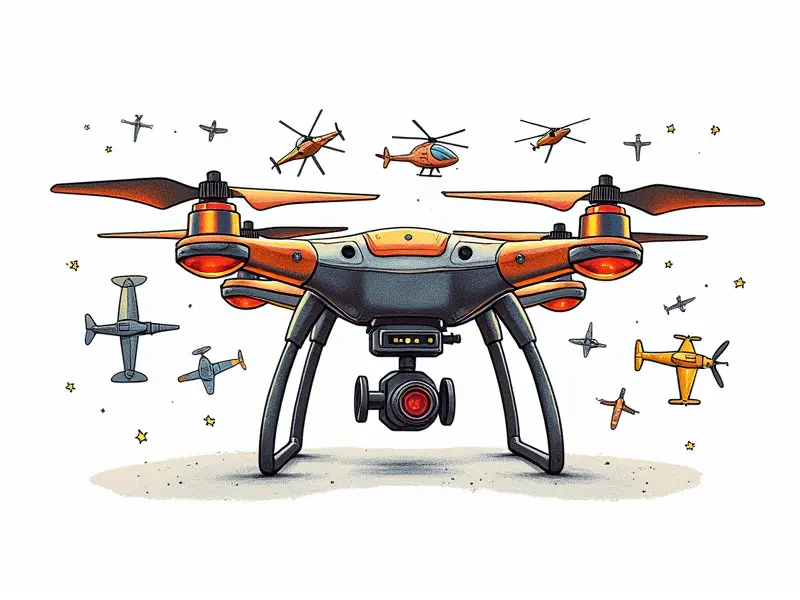Why do FPV racers crash so much?

Why Do FPV Racers Crash So Often?
First-person view (FPV) drone racing has gained immense popularity in recent years, captivating enthusiasts and spectators alike with its high-speed action. However, one aspect of this exhilarating sport that often draws attention is the high frequency of crashes. In this article, we will explore why FPV racers crash so frequently and what can be done to mitigate these incidents.
Common Reasons for FPV Drone Crashes
The thrill of FPV racing comes with inherent risks due to several factors:
- Limited Visibility: Pilots rely on a live video feed from the drone's camera, which can be obstructed by trees, buildings, or other obstacles.
- High Speeds: FPV drones often reach speeds exceeding 100 mph (160 km/h), making it challenging to react quickly and avoid collisions.
- Tight Turns: The race courses are designed with sharp turns and tight corners, requiring precise control and quick reflexes from the pilot.
Top Causes of FPV Racing Accidents
The primary causes behind frequent crashes in FPV racing include:
- Lack of Experience: New pilots often struggle to master the skills required for high-speed navigation and obstacle avoidance.
- Mechanical Failures: Drone components can malfunction due to wear and tear, leading to unexpected crashes.
- Pilot Fatigue: Extended racing sessions can lead to mental fatigue, reducing the pilot's ability to maintain focus and react swiftly.
Understanding Why FPV Racers Crash Repeatedly
The repetitive nature of crashes in FPV racing can be attributed to several underlying issues:
- Inadequate Training: Insufficient training programs leave pilots unprepared for the challenges posed by high-speed racing.
- Poor Maintenance Practices: Neglecting regular maintenance and inspections increases the likelihood of mechanical failures during races.
- Risk-Taking Behavior: The competitive nature of FPV racing encourages pilots to take risks, often resulting in crashes as they push their limits.
The Most Common Mistakes in FPV Racing
Mistakes that lead to frequent crashes include:
- Failing to Check the Course: Pilots who do not thoroughly familiarize themselves with the race course are more prone to errors.
- Lack of Pre-Race Checks: Skipping pre-race inspections can result in undetected issues that cause crashes during the event.
- Overconfidence: Experienced pilots may become overconfident and neglect safety precautions, leading to preventable accidents.
Preventing Crashes in FPV Drone Racing
To reduce the frequency of crashes, consider implementing these strategies:
- Enhanced Training Programs: Develop comprehensive training programs that cover all aspects of FPV racing, including safety and technical skills.
- Rigorous Maintenance Procedures: Establish strict maintenance protocols to ensure drones are in optimal condition before each race.
- Safety Gear and Protocols: Encourage the use of protective gear such as helmets and goggles, and enforce safety rules during events.
Why FPV Racing Is So Accident-Prone
The high accident rate in FPV racing is due to a combination of factors:
- Variability of Conditions: Race conditions can change rapidly, affecting visibility and stability.
- Dynamic Nature of the Sport: The fast-paced nature of FPV racing requires constant adaptation and quick decision-making.
- Limited Feedback Loop: The real-time video feed provides limited sensory input compared to traditional piloting methods, increasing the risk of errors.
Tips to Avoid Crashes in FPV Drone Racing
To minimize crashes and enhance safety, follow these tips:
- Practice Regularly: Consistent practice helps improve skills and reaction times.
- Use Quality Equipment: Invest in high-quality drones and accessories to reduce the risk of mechanical failures.
- Stay Calm Under Pressure: Maintaining composure during races can help pilots make better decisions and avoid reckless maneuvers.
Why FPV Racers Struggle with Stability
The challenge of maintaining stability in FPV racing stems from several factors:
- Wind Conditions: Wind gusts can destabilize drones, making it difficult to maintain control.
- Obstacle Density: Dense environments with numerous obstacles require constant adjustments and careful navigation.
- Pilot Fatigue: Extended periods of intense focus can lead to decreased stability as pilots become fatigued.
Understanding the High Crash Rate in FPV Racing
The high crash rate in FPV racing reflects a complex interplay between technical, environmental, and human factors. By addressing these issues through better training, maintenance, and safety protocols, we can work towards reducing accidents and enhancing the overall experience for pilots and spectators.
The Main Reasons for FPV Drone Failures
FPV drone failures often occur due to:
- Battery Issues: Weak batteries or improper charging practices can lead to sudden power loss during races.
- Motor Malfunctions: Overheating and wear can cause motors to fail, resulting in unexpected crashes.
- Signal Interference: Electromagnetic interference from other devices can disrupt the connection between the drone and controller.
Conclusion
The high crash rate in FPV racing is a multifaceted issue that requires a comprehensive approach to address. By improving training programs, enhancing maintenance practices, and adopting safety protocols, we can reduce accidents and ensure a safer and more enjoyable experience for all participants.

